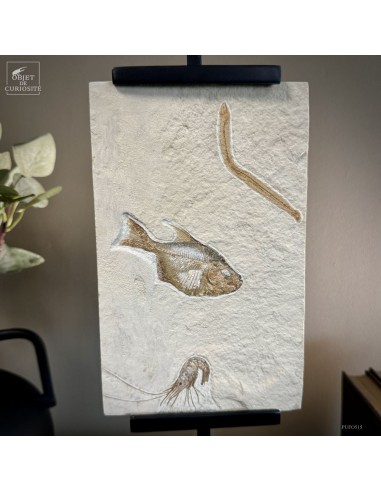- New
Fish DIPLOMYSTUS, shrimp CARPOPENAEUS and eel HAYENCHELYS GERMANUS
PUFO515
This limestone slab brings together three iconic marine fossils from the Late Cretaceous period, frozen in time for nearly 95 million years: the beginning of the Cretaceous period. It comes from famous deposits in Lebanon, in the province of Byblos. These limestone formations of Hajoula are well known to collectors and museums because the Cretaceous fauna has been perfectly preserved there, including sometimes the “soft tissues” of squids and jellyfish. These are the most beautiful marine fossils known, thanks to the absence of oxygen in the water at the time of their death, following torrential rains that led to an overgrowth of microorganisms that consumed all the oxygen.
This fossil of a DIPLOMYSTUS fish, a CARPOPENAEUS shrimp, and a HAYENCHELYS GERMANUS eel perfectly illustrates the abundance of the waters of the Tethys, the ancient Mediterranean Sea. It is a true snapshot of the Cretaceous period. The delicate bones of the fish, the long antennae of the shrimp, and the sinuous body of the eel appear almost suspended in motion, transforming a natural event into a geological tableau.
A rare collectible fossil.
This fossil of a DIPLOMYSTUS fish, a CARPOPENAEUS shrimp, and a HAYENCHELYS GERMANUS eel perfectly illustrates the abundance of the waters of the Tethys, the ancient Mediterranean Sea. It is a true snapshot of the Cretaceous period. The delicate bones of the fish, the long antennae of the shrimp, and the sinuous body of the eel appear almost suspended in motion, transforming a natural event into a geological tableau.
A rare collectible fossil.












